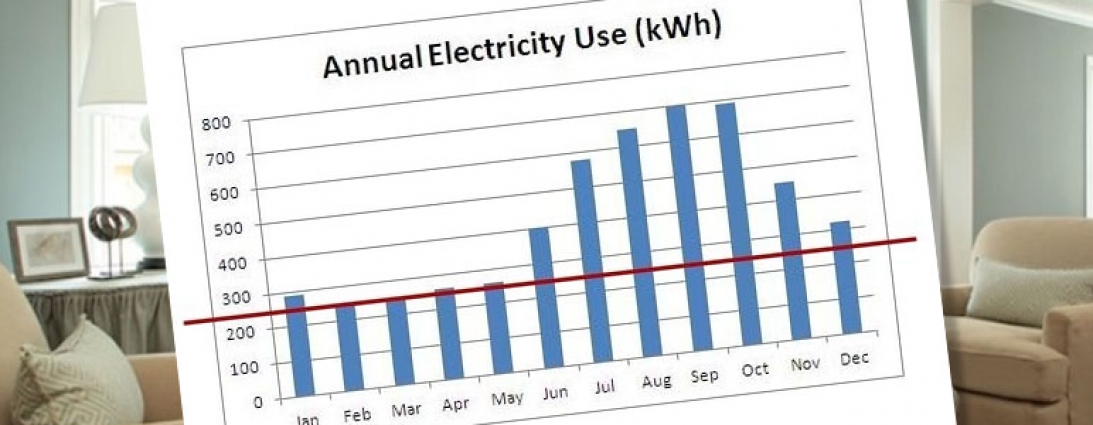

Looking for ways to lower your energy bills? Understanding the numbers and graphs on your bill can help you determine your home's biggest energy users. This article is specifically written for San Diego Gas & Electric customers, but many of the lessons are useful to any energy utility customer.
Seasonal vs. baseload
Seasonal energy use is just what it sounds like – the energy you use seasonally for space heating and cooling. On your SDG&E bill, you’ll see a “usage history” that displays your electric and natural gas consumption over the past year. On the example shown above, the seasonal energy use is everything above the red line. If you have a big spike in electric use in summer/fall (heat waves can last until November in San Diego), it’s probably due to your air conditioner working overtime. You may also see a spike in electricity or natural gas usage during the winter months, depending on which fuel source your heating system uses.
Baseload energy, on the other hand, is the energy you use year-round (everything below the red line on our example). For many of us, our baseload natural gas usage is due almost entirely to our water heater. Our baseload electric use is due to our lighting, electronics, appliances, and anything electric we use throughout the year.
Daily and hourly energy use
More detailed clues to your home’s big energy users can be found at sdge.com . If you haven’t created an online account yet, take two minutes and set it up – there’s a wealth of information available. Once you’re logged in, click on “My Energy” and go to the energy charts. You can see your electric use on a weekly, daily, or hourly basis – alongside the daily temperature – and begin to correlate what activities cause spikes in your consumption. A particularly hot day might cause your electric use to spike in the afternoon. Maybe your kids came home from college for a week and your baseload electricity use went up. Experiment with different thermostat settings and unplugging unused electronics for a week at a time, and see how the graphs change. SDG&E’s website also allows you to compare your energy use to your neighbors’ energy use, so go ahead and see how you measure up!
Tiers 1-4
All kilowatt-hours are not priced equal in SDG&E territory. The more you use, the more expensive each kilowatt-hour becomes. Going back to your bill, you’ll see a partially-shaded bar indicating which pricing tier you fell into that month. The tier thresholds and prices vary by climate zone and other factors, but the trend is always the same. The kilowatt-hours you use in Tier 1 are significantly cheaper (in our example, 14 cents/kWh for the first 336 kWh used) than the kilowatt-hours you may use in Tier 4 (33 cents). If your air conditioner is your biggest energy hog, you might fall into Tier 4 in the summer/fall, but stay in a lower tier the rest of the year. The goal, of course, would be to keep your electric use low enough to stay in Tier 1 the entire year – like the home in our example above, which used 269 kWh for the month.
Bringing down the bill
Your bill and online account have given you clues about your biggest energy users – air conditioning, furnace, water heating, lighting and appliances, etc. If your furnace is running up your bill in winter, the solution might be to add insulation, seal air leaks and/or get a more efficient furnace. If you need to lower your natural gas usage year-round, consider reducing your water heater temperature (120 degrees is sufficient) and getting lower-flow showerheads. If your plug-load is high year-round, you might need to change out your light bulbs, get rid of the 1980s-era fridge sucking down power in your garage or use a power strip to shut down your video games and cable boxes when not in use.
Learning more
Want even more info about how your home uses energy? A home energy rating will pinpoint the causes of energy waste in your home, provide recommendations for energy improvements, and let you know how your home compares to other homes. The more you know, the more power you have to smooth out those seasonal energy spikes, bring yourself back to Tier 1, and reduce your monthly utility bills for good!
